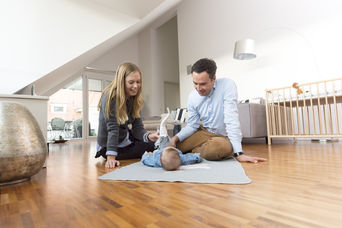Clean air: Healthy homes for allergy sufferers
Just take a deep breath and enjoy the good things in life – that’s what your home is meant for. Allergy sufferers, however, may find this quite difficult. If the indoor air is filled with substances that trigger allergic reactions, they can no longer feel good in their own four walls. Allergens should therefore not be allowed to “sneak” inside. Pollen and animal hair are well-known allergy triggers, but also building materials can contain allergens. We will answer the question of how you can best “screen” your home for potentially allergenic materials.
1. Beware of false advertising promises
Unfortunately, there is no such thing as completely allergen-free houses and building products. Some health labels and manufacturers make misleading advertising claims. But that’s just hot air. Even if certain materials statistically have a higher allergenic potential, every person reacts differently. Some allergens are also introduced in trace amounts by precursors – without the manufacturer knowing or being able to control this. That is especially true for natural products. “Completely natural materials” such as wood, wool or oils can very often trigger allergies. The decisive factor is the individual tolerance of each person.
2. Choose materials that are compatible with your allergy
What is well tolerated by one person or even edible food can have a serious impact on the health of others. Allergic reactions therefore need to be examined on a case-by-case basis. In a first step, it is necessary to identify the type of allergy and the allergy triggers. In a second step, the interior design can be adapted to it. For this purpose, suitable building materials must be chosen that contain essentially harmless ingredients and have the least sensitizing effect.
3. Use materials that ensure healthy living
“Clean” indoor air takes top priority – not only for allergy sufferers. Healthy building and installation products with the lowest emissions worldwide are recognizable by the EMICODE® seal on the packaging. The content of VOCs emitted into the indoor air is determined by independent laboratories. Regular spot checks by neutral experts and testing institutes ensure long-term compliance with the limit values. This distinguishes EMICODE® from other certificates for health and environmental compatibility.
4. Follow the rules of thumb
Other general tips can help to make your home as allergen-free as possible. Solidly built houses, made for instance of cellular concrete, feature a lower allergen level than wooden buildings. The latter are often treated with preservatives and insecticides. Smooth, wipeable floor coverings or short- rather than long-pile carpets help prevent house dust mites. Underfloor and wall heating systems do not stir up dust. Ventilation systems with built-in pollen filters protect against hay fever and prevent mold growth. To ensure the proper exchange of air, windows should be opened as wide as possible several times a day to produce short periods of draft.

©GEV
Share article on Social Media:
